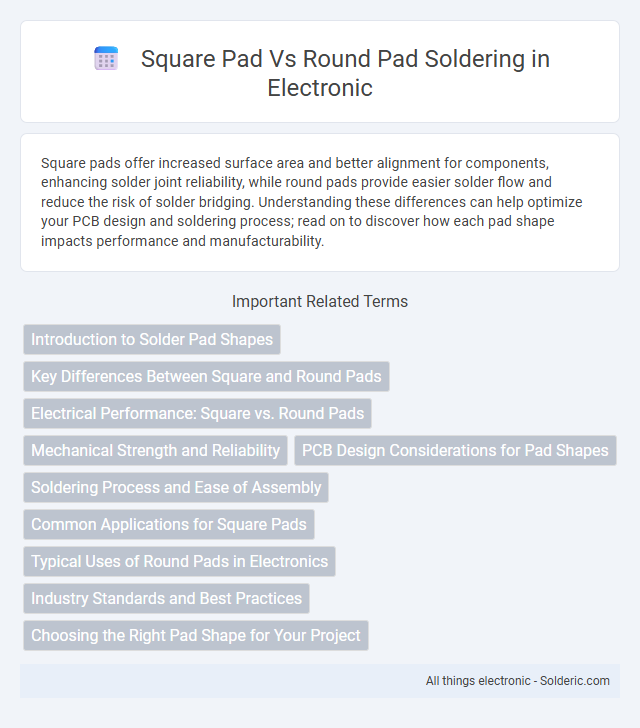Square pads offer increased surface area and better alignment for components, enhancing solder joint reliability, while round pads provide easier solder flow and reduce the risk of solder bridging. Understanding these differences can help optimize your PCB design and soldering process; read on to discover how each pad shape impacts performance and manufacturability.
Comparison Table
| Feature | Square Pad | Round Pad |
|---|---|---|
| Shape | Square with sharp corners | Rounded, circular |
| Solderability | Better solder fillet formation | Good solder flow but less fillet control |
| Component Alignment | Helps precise alignment due to edges | Less alignment guidance |
| Heat Distribution | Uniform heat, reduces cold joints | Good heat, but slight hotspots possible |
| Common Usage | Used for PCB components requiring strong mechanical support | Popular in through-hole and surface mount pads |
| Manufacturing Complexity | More precise etching required | Simple etching process |
| Reliability | High mechanical and electrical reliability | Good reliability but less mechanical strength |
Introduction to Solder Pad Shapes
Square solder pads provide a larger surface area for component leads, enhancing mechanical stability and heat dissipation during soldering processes. Round pads facilitate easier solder wetting and reduce the risk of solder bridging, especially for fine-pitch components. Choosing between square and round pads depends on factors like component type, thermal requirements, and manufacturing precision.
Key Differences Between Square and Round Pads
Square pads provide larger surface area and improved heat dissipation compared to round pads, enhancing solder joint reliability and thermal management. Round pads are typically easier for automated pick-and-place machines to handle and can reduce solder bridging risks due to their symmetrical shape. The choice between square and round pads affects solderability, mechanical strength, and board layout efficiency in electronic assembly.
Electrical Performance: Square vs. Round Pads
Square pads offer a larger surface area than round pads, enhancing solder joint strength and electrical conductivity for improved circuit reliability. The increased contact area of square pads results in lower resistance and better heat dissipation compared to round pads, optimizing signal integrity. Choosing the right pad shape can directly affect your PCB's electrical performance and long-term durability.
Mechanical Strength and Reliability
Square pads provide enhanced mechanical strength due to their larger surface area, which improves solder joint adhesion and reduces the risk of pad lifting under mechanical stress. Round pads offer better stress distribution around the solder joint, minimizing crack propagation and enhancing long-term reliability in dynamic applications. Your choice between square and round pads should balance the need for robust mechanical support with the specific reliability requirements of the electronic assembly.
PCB Design Considerations for Pad Shapes
Square pads provide better alignment and precise placement during PCB assembly due to their defined edges, which enhances solder joint reliability. Round pads reduce stress concentration and improve thermal distribution, minimizing the risk of pad lifting during thermal cycles. Designers must balance mechanical stability and thermal performance by selecting pad shapes aligned with component size, heat dissipation requirements, and soldering process constraints.
Soldering Process and Ease of Assembly
Square pads provide a larger surface area, enhancing heat absorption during the soldering process and improving solder joint reliability. Round pads simplify alignment by naturally guiding the soldering iron, reducing the risk of bridging and promoting consistent solder flow. The ease of assembly often favors round pads for automated processes, while square pads benefit manual soldering by offering better visual cues for component placement.
Common Applications for Square Pads
Square pads in soldering are commonly used for components that require strong mechanical stability, such as connectors, switches, and power devices where reliable solder joints are critical under mechanical stress. Their increased surface area compared to round pads enhances heat dissipation and facilitates better solder fillet formation, resulting in improved electrical and thermal performance. Square pads are also preferred for through-hole components and test points to provide easier inspection and rework capabilities.
Typical Uses of Round Pads in Electronics
Round pads are typically used in electronics for through-hole components, providing a strong mechanical bond and efficient electrical connection. They are ideal for mounting components such as resistors, capacitors, and diodes on printed circuit boards (PCBs), especially where axial leads need secure soldering. Your designs benefit from the consistent solder fillets and ease of inspection offered by round pads in standard PCB assemblies.
Industry Standards and Best Practices
Square pads provide enhanced solder joint stability and are favored in high-reliability applications adhering to IPC-7351 standards, which recommend pad shapes based on component lead geometry. Round pads facilitate easier soldering and inspection, commonly specified in consumer electronics for streamlined manufacturing processes. Industry best practices dictate selecting pad shapes that optimize thermal management and mechanical strength in line with the PCB assembly requirements and IPC guidelines.
Choosing the Right Pad Shape for Your Project
Selecting the right pad shape for soldering depends on your project's precision and component type; square pads offer better grip and alignment for surface-mount devices, while round pads provide flexibility and ease of solder flow for through-hole components. Your choice affects solder joint reliability and manufacturing efficiency, with square pads enhancing mechanical strength and round pads simplifying rework. Consider component size, thermal management, and assembly method to optimize solder performance and durability.
Square pad vs round pad soldering Infographic

 solderic.com
solderic.com